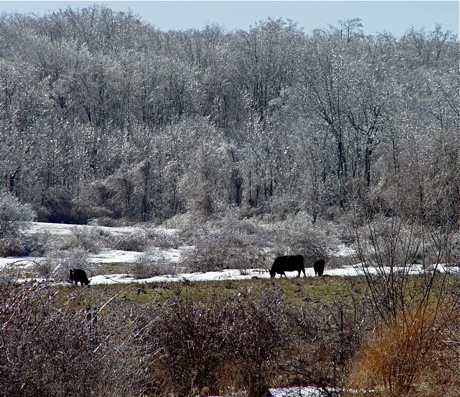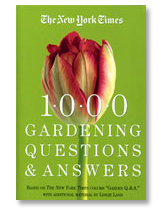Planting Potatoes
March came in with a gorgeous ice storm. Greening up on hold.
Shortly afterward it got warmer – pleasant even – although there were still large heaps of dispirited snow in the shady spots. But gradually (very gradually), the heaps diminished to tiny piles. We heard peepers. The crocus, early iris and eranthus began to bloom.

One thing I love about eranthus are those frilly skirts. Another is their cheerful willingness to multiply.
As further encouragement, we have now had St Patrick’s day, aka Make Soda Bread day and the first day of spring and the arrival of two of my favorite fall catalogs – Brent and Becky’s Bulbs and Adelman peonies. Definitely planting time, even if it is going to be 14 – 16 degrees at night for most of the coming week.
As usual, I have a good supply of things to plant “as soon as the ground can be worked.” What I wish I had more of is patience, because unfrozen is not enough. “Can be worked” also means “not sopping wet.” If you grab a handful of the soil and it sticks together like clay when you open your fingers, it’s too soon to plant no matter what the temperature.
This is the part where I’m glad the Hudson Valley garden is built on top of an old railroad bed. After 20 years of improvement it’s still an evil nest of stones that thwarts every attempt to set a stake or insert a shovel, but you can’t beat it for drainage. Even though it’s still more than six weeks before average last frost, the soil will shortly be crumbly enough to plant :
Lettuce
Rocket (arugula)
Parsley
Coriander
Poppies
and
Peas – but not sugar snaps, which need warmer soil, and not quite yet sweet peas, the seedlings of which are a bit less frost tolerant than those of edible peas.
Also not time yet for carrots, beets or cole crops and definitely not time to plant potatoes; they shouldn’t go in until frost season is almost over. But back there with the soda bread, several St. Patrickses ago, I made a loose promise to discuss potato planting at potato planting time and then…
Planting Potatoes
It’s easy; potatoes are determined to grow and as they come with their own food supply they will grow for quite a while with no encouragement at all.
The Classic Method
Choose a spot in the garden that gets full sun and has well drained, fertile, slightly acid soil, innocent of fresh manure. Dig an 8 or 9 inch deep trench, piling the excavated soil at the edges.
Set the pieces of seed stock in the trench eyes up, well apart, according to the instructions for the variety. Resist the urge to use it all up if you’ve got more seed than planting space; too-close planting is likely to produce lots of little potatoes that don’t store well.
Cover with a couple of inches of soil, then stand back and let ‘er rip, gradually filling in the trench as the stems grow, then piling on yet more soil (or straw) so that by the time the plants are bushy they’re growing out of a mound of darkness.
The potatoes form on stems growing above the seed piece and the more buried stem you have, the more tubers you’ll get. Within reason. The plants have to switch from stems to leaves fairly early or there won’t be anything to convert sunshine into potatoes.
The Less-Work, Easier Harvest Straw Pile Method
For a while there, various back to the land publications were pushing potato planting minimalism: Scratch out a shallow depression in any soil not heavily infested with perennial weeds. Plant the potatoes. As they grow, keep covering them with straw. Water frequently, potatoes need consistent moisture. Don’t let the straw get soggy, potatoes rot in wet soil. Pull any weeds that appear.
When the potatoes flower, there should be a few new potatoes available for gentle removal, and at the end of the season you will have a heap of rotting straw with potatoes in it.
I have actually done this, about 30 years ago, and it worked pretty well, but it didn’t work nearly as well as using the straw pile method on potatoes planted in shallow trenches in fertile garden soil that was more or less weed free to start with.
Plus voles, field mice and rats, which are the dark side of all heaps of straw no matter what you’re doing with them. (This is perhaps the right place to mention that domestic cats, notorious killers of birds, got domesticated for a very good reason and I’m not talking about being cute.)
For more detailed instructions, consult this handy potato planting PDF for home gardeners from the University of Maine. Everything you need to know except how to avoid fungus diseases like late blight without using conventional fungicides. For that, it’s Organic Alternatives for Late Blight Control in Potatoes, from the National Sustainable Agricultural Information Service and when they say information they ain’t kidding. The preventives and remedies described are applicable to most other crops and most other fungal threats.
* Two reasons these potatoes are unsuitable for planting:
1. Because I bought them to eat, not to plant, I didn’t pay any attention to whether they might be carrying blight or other potato diseases.
2. They have already exhausted their energy making those long shoots. Nothing left to make roots with or to support the production of the first sets of leaves. Pre-sprouting seed potatoes (called chitting) gives them a good head start, but that’s done in good light and cool conditions, producing short fat green sprouts that look like little stars.
Ice storm photo by Bill Bakaitis

















Ah, so not only can we, but we should toss that unsightly nest of sprouting potatoes that has grown up in our pantry!
Beautiful photo from early march!
I am greatly enjoying your blog/online magazine, and will continue to check it out as the garden season continues. Here in Vermont I’ve just planted some snow peas and frost-tolerant greens outside under row cover, but not yet potatoes. Probably this or next week. The problem (and joy) with April is all the rain and I’m afraid to plant potatoes before a big rain storm!
Feel free to check out my blog as well – it focuses not only on our gardens but also eco-friendly home renovations and random other tidbits of life.
Thanks,
Melissa